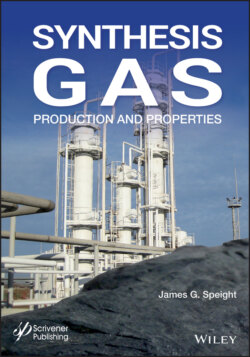Читать книгу Synthesis Gas - James Speight G., James G. Speight - Страница 55
2.5.5.7 Catalytic Gasification
ОглавлениеCatalysts are commonly used in the chemical and crude oil industries to increase reaction rates, sometimes making certain previously unachievable products possible (Speight, 2002; Speight, 2014a; Hsu and Robinson, 2017; Speight, 2017). Acids, through donated protons (H+), are common reaction catalysts, especially in the organic chemical industries. This it is not surprising that catalysts can be used to enhance the reactions involved in gasification and use of appropriate catalysts not only reduces reaction temperature but also improves the gasification rates.
In addition, thermodynamic constraints of the gasification process limit the thermal efficiency are not inherent but the result of design decisions based on available technology, as well as the kinetic properties of available catalysts. The latter limits the yield of methane to that obtainable at global equilibrium over carbon in the presence of carbon monoxide and hydrogen. The equilibrium composition is shown to be independent of the thermodynamic properties of the char or feedstock. These limitations give non-isothermal two-stage processes significant thermodynamic advantages. The results of the analysis suggest directions for modifying present processes to obtain higher thermal efficiencies, and a two-stage process scheme that would have significant advantages over present technologies and should be applicable to a wide range of catalytic and non-catalytic processes (Shinnar et al., 1982; McKee, 1981).
Alkali metal salts of weak acids, such as potassium carbonate (K2CO3), sodium carbonate (Na2CO3), potassium sulfide (K2S), and sodium sulfide (Na2S) can catalyze the carbon-steam gasification reaction. Catalyst amounts on the order of 10 to 20% w/w K2CO3 will lower the temperature required for gasification of bituminous coal from approximately 925°C (1695oF) to 700°C (1090oF) and that the catalyst can be introduced to the gasifier impregnated on coal or char.
Disadvantages of catalytic gasification include increased materials costs for the catalyst itself (often rare metals), as well as diminishing catalyst performance over time. Catalysts can be recycled, but their performance tends to diminish with age or by poisoning. The relative difficulty in reclaiming and recycling the catalyst can also be a disadvantage. For example, the potassium carbonate catalyst can be recovered from spent char with a simple water wash, but some catalysts may not be so accommodating. In addition to age, catalysts can also be diminished by poisoning. On the other hand, many catalysts are sensitive to particular chemical species which bond with the catalyst or alter it in such a way that it no longer functions. Sulfur, for example, can poison several types of catalysts including palladium and platinum.
